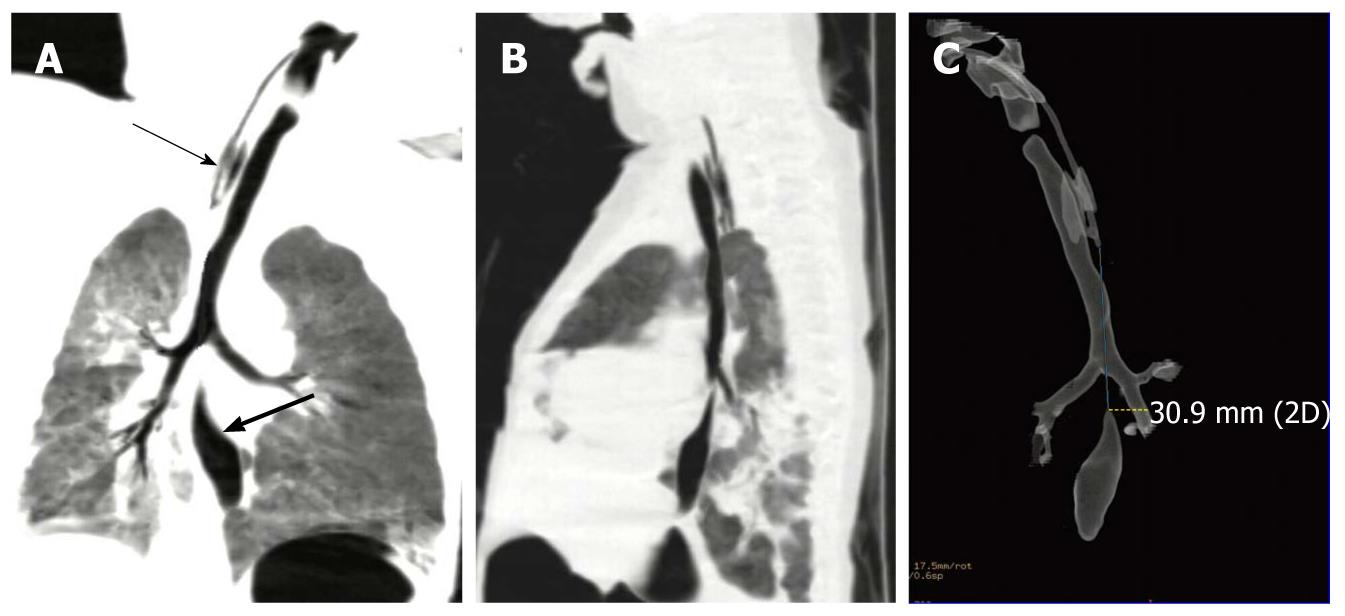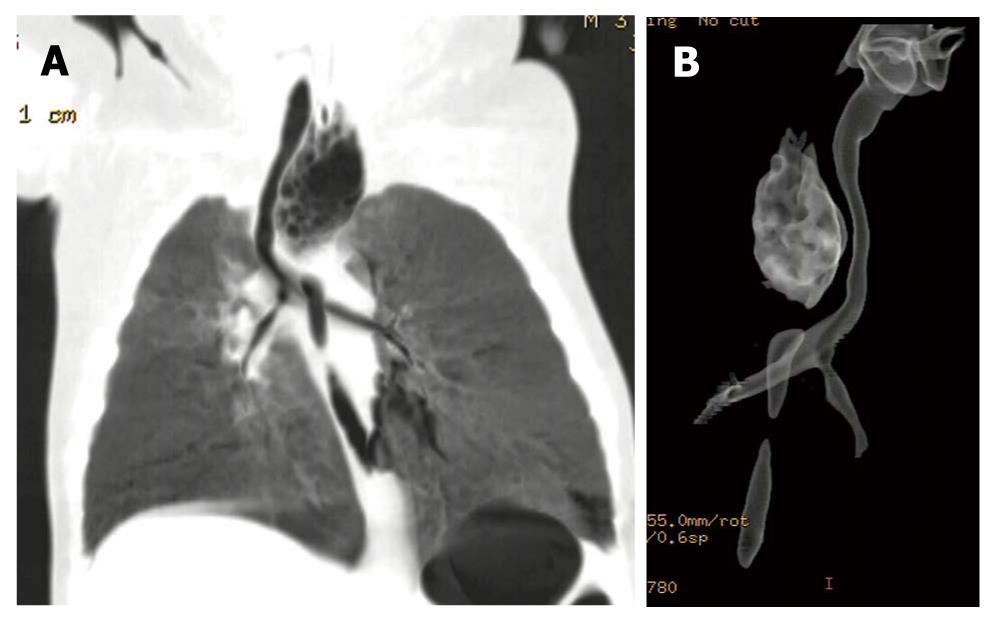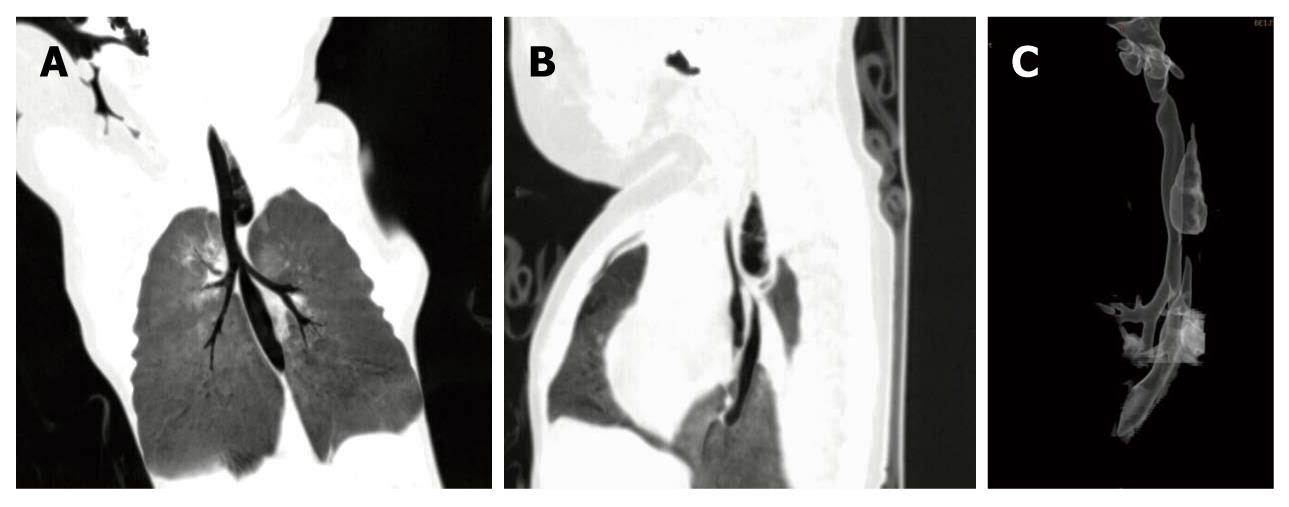Copyright
©2011 Baishideng Publishing Group Co.
World J Gastroenterol. Mar 28, 2011; 17(12): 1649-1654
Published online Mar 28, 2011. doi: 10.3748/wjg.v17.i12.1649
Published online Mar 28, 2011. doi: 10.3748/wjg.v17.i12.1649
Figure 1 The reconstruction techniques of multidetector-row computed tomography show a case of esophageal atresia and tracheoesophageal fistula with a long inter-pouch gap.
A: Coronal view of multiple planar volume reconstruction showing a long gap between the proximal pouch (thin arrow) and distal pouch (thick arrow) as well as the tracheobronchial tree with an aspirating catheter in the proximal esophageal pouch; B: Oblique sagittal view of multiple planar volume reconstruction showing a long inter-pouch distance with a tenuous fistula; C: Posteroanterior projection of transparency lung volume rendering demonstrating the distance between esophageal segments and three-dimensional anatomy of esophageal pouches and tracheobronchial tree after removal of lungs in case 3 (a 3-d old male neonate).
Figure 2 The reconstruction techniques of multidetector-row computed tomography clearly demonstrate not only inter-pouch distance but also the distal fistula.
A: Coronal view of multiple planar volume reconstruction showing esophageal pouches and tracheobronchial tree; B: Oblique sagittal view of multiple planar volume reconstruction demonstrating inter-pouch distance and tracheal connection with the distal esophageal pouch; C, D: Transparency lung volume rendering showing anteroposterior (C) and sagittal projection (D) in three-dimensional anatomy of esophageal pouches and fistula in case 8 (a 5-d old male infant).
Figure 3 The proximal esophageal pouch full of air was distended and pressed the trachea rightwards.
A: Coronal view of multiple planar volume reconstruction showing a short inter-pouch gap, a distended proximal esophageal pouch, and rightward- shifted trachea; B: Oblique posteroanterior view of transparency lung volume rendering demonstrating the three-dimensional anatomy of esophageal pouches and shifted trachea case 6 (a 3-d-old female neonate).
Figure 4 Multiple planar volume reconstruction revealed the inter-pouch distance and the thin fistula which was not visualized by transparency lung volume rendering.
A: Coronal view of multiple planar volume reconstruction showing esophageal segments and tracheobronchial tree; B: Oblique sagittal view of multiple planar volume reconstruction showing inter-pouch distance and tracheal connection with the distal esophageal pouch; C: Oblique sagittal view of transparency lung volume rendering demonstrating the three-dimensional anatomy of esophageal pouches but no fistula in case 20 (a 4-d old male infant).
Figure 5 Scattered plots about the findings of the reconstruction techniques of multidetector-row computed tomography and surgery.
Scattered plot showing gaps determined by multiple planar volume reconstruction (MPVR) (y-axis) and observed at surgery (x-axis) (A), by transparency lung volume rendering (TL-VR) (y-axis) and observed at surgery (x-axis) (B) in 17 patients, and by MPVR and TL-VR (C) in 20 patients.
- Citation: Wen Y, Peng Y, Zhai RY, Li YZ. Application of MPVR and TL-VR with 64-row MDCT in neonates with congenital EA and distal TEF. World J Gastroenterol 2011; 17(12): 1649-1654
- URL: https://www.wjgnet.com/1007-9327/full/v17/i12/1649.htm
- DOI: https://dx.doi.org/10.3748/wjg.v17.i12.1649













